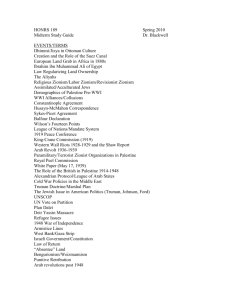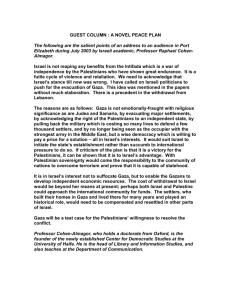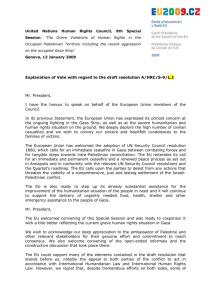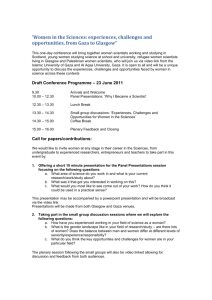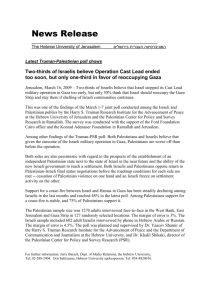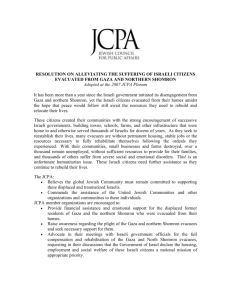Ethics of Online Video/Photo Sharing
advertisement
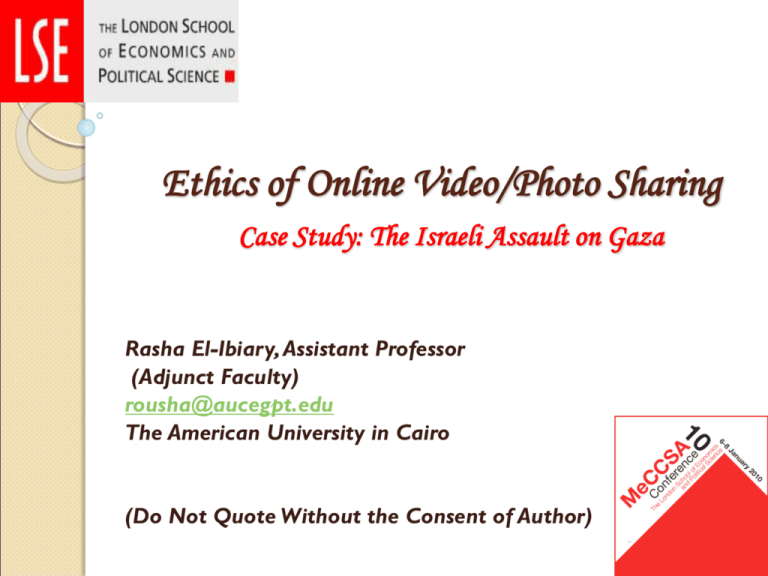
Ethics of Online Video/Photo Sharing Case Study: The Israeli Assault on Gaza Rasha El-Ibiary, Assistant Professor (Adjunct Faculty) rousha@aucegpt.edu The American University in Cairo (Do Not Quote Without the Consent of Author) Abstract In the wake of the Israeli assault on Gaza, pictures and videos of death, pain, agony and destruction flooded the Internet in a possibly unprecedented fashion. Not just the quantity of those moving and still images, but even more significant was their appalling nature, featuring dead bodies of children, women, and elderly, piles of dead bodies abandoned in the street, burned bodies, dismantled bodies and cut out human parts. This daily bloody visual dosage that piled the internet during 25 consecutive days, and widely circulated through social networking sites, especially Facebook, empowered with sharing options, played a most significant role in turning the international public opinion, by-and-large in favor of the Palestinian cause and against the Israeli massacre and decisive cleansing committed against innocent civilians under-siege from air, land and sea. This research aims to closely inspect, analyze and theorize how ethics are being reconfigured through the digital, rearticulated through online politics, creating news social and mobile propaganda and digital ethics, breaking the boundaries between the global and the local, the personal, the shared and the collective, ushering new value system and setting new collective agenda for a new ‘global’ online audience. I-Image Ethics, Sharing and Popular Geopolitics 1- Briefing: This research discusses the ethical dimension of the circulation of pictures of death, pain, agony and destruction, especially in the age of the internet and the proliferation of social networking websites like Facebook and the like, and the global repercussions of this. Conducting visual content analysis on 50 photographs and 10 videos, as well as an online survey amongst 100 users and members of Facebook groups who normally share affective pictures for a variety of reasons, was the tool to test the ethical dimension of video/photo sharing. I-Image Ethics, Sharing and Popular Geopolitics 2- Web 2.0 and Popular Geopolitics The internet as a tool of globalization is at the same time a double ended sword. As much as it is perceived that Web 2.0 and social networking websites provide users with unlimited freedom of communication, thereby empowering citizens vis a vis their governments, the limits of such freedom are still questionable, opening up the way for governments to exercise unlimited control and surveillance. As a highly appealing form of entertainment, especially amongst its users and addicts, Web 2.0, I argue, it plays a central role as a form of popular geopolitics, whereby citizens of the entire globe use it “to make sense of their events and in their own locale, country, region and the wider world” (Claus Dodds). I-Image Ethics, Sharing and Popular Geopolitics 3- Problematizing Image Ethics: The ethics of the mediatization of affective imagery in conventional media has been approached by many authors leaving us with multiple/sometimes contradictory viewpoints. Some argue the abundant supply of affective imagery via mass media has dulled our senses and led us to what Susan Moeller describes as ‘compassion fatigue’ While other authors, like David Campbell and Anna Gibbs, argue that affective imagery when used responsibly can make a difference in the lives of featured subjects. I-Image Ethics, Sharing and Popular Geopolitics The inherent inability a traumatic image to communicate pain raises many ethical question about the unlimited online circulation of such imagery, whose interests it is serving? And whether this harms or benefits the featured victims best interests, and those who survived the harm?? Since images can only convey a visual expression of pain, they inevitably fall into a politics of representation that simply ‘flattens the experience of pain’ and turns it into ‘an iconography of symbols,’ (Dauphinee, 2007). In this way images turn out to become symbolic of special events, starving children, hooded prisoners, bleeding war victims, and so on. I-Image Ethics, Sharing and Popular Geopolitics In the processes of imaging and visualizing pain and trauma, the experience/existence of pain is totally excluded. By its nature, pain is a ‘uniquely inexpressible experience,’ according to Scarry, it is ‘somewhat less visible… so nearly impossible to express, so flatly invisible,’ (cited by Dauphinee, 2007). Painful images are, thus, nominally perceived with ‘radical uncertainty’ and ‘doubt,’ since their ‘presence or absence cannot be objectively verified,’ says Dauphinee. The ambiguity of traumatic images opens up the way for suspecting their originality, and thus, eases the process of turning them into politicized icons of specific events. I-Image Ethics, Sharing and Popular Geopolitics Affective imagery is often circulated in conventional media to meet political ends: to show off power, to illustrate the brutality of an enemy, or to gain support on policies which would not be otherwise approved. Using common metaphors, crisis images depend on logical stereotypes, ‘the heroic doctor, the brutal tyrant, the sympathetic aid worker, the barbaric mercenaries, the innocent orphans, the conniving politicians, and so on. The images induce the public to fit these models into the current crisis.’ (Susan Moeller) I-Image Ethics, Sharing and Popular Geopolitics The politics leading to the Western media’s abstention from displaying affective images of death and human corpses not only reflect cultural/governmental sensitivities, but also point to a refrain from taking responsibility for the existence of such images/occurrences. ‘The perpetrators of the traumas imposed upon ethnic, racial and religious minorities would prefer to forget about the past and to pretend that the atrocities did not occur,’ (Nytagodien and Neal, 2004). The disappearance of such dreadful imagery, as well as the proliferation of ‘sanitized’ coverage, is aimed at avoiding taking ‘ethical’ responsibility for such crimes, as well as dehumanizing the victims of tragic events by negligence and disremembrance. I-Image Ethics, Sharing and Popular Geopolitics After 30 years of Foucault, Derrida and Braudillard anyone can confidently claim that photographs lie, manipulate, and oppress. They reveal their own prejudices never objective reality. Yet upon those mysterious, morally stained documents we rely—get our news of the world, to form our ethical and political consciousness, and even sometimes to take actions. According to Anna Gibbs, ‘The image is inevitably partial in both senses of the word: not only does it tell what we might call a situated truth, it can never tell the whole truth.’ Photographs of pain fail to offer a coherent explicated knowledge because they are photographs, which is to say, they are isolated fragments of a larger truth. Photographs surely show us something, but just as surely they tell us nothing, they are inherently lacking narrative powers. According to Sontag, they are “invitations to deduction, speculation and fantasy.” I-Image Ethics, Sharing and Popular Geopolitics 4-Ethics of Online Video/Photo Sharing A photograph’s ability to convey truth is limited, and can never be fixed. The photopraph of suffering inform us that people all over the world need emergency, donations, food medicine and blankets, but societies not the sustained chance to create based on democracy, equality and freedom of choice. This raises a number of imminent ethical questions: - Who is sharing the photos? - What is the nature/content of shared photos? - Who is the perpetual audience of shared images? - What effect does those images spark, if any? I-Image Ethics, Sharing and Popular Geopolitics 5- Hypothesis The central argument in this research is that the unlimited exposure and circulation of the pain of others is no more than a form of relieving the guilt for “not doing anything” for them, it gives the user the illusion that they are “doing something” for them—exposing the Israeli crimes against humanity committed against innocent civilians— and indirectly harms the victims by showing the images in a context of hopelessness, suggesting a situation is irresolvable and hopeless. II- Case Study: The Israeli Assault on Gaza 1- Background More than 1,300 Palestinians in the Gaza Strip were killed during 25 days of Israeli shelling from sea, air and land. Palestinians in Gaza had nowhere to flee from Israel's onslaught as the border has been closed for two years, with disastrous consequences for the 1.5 million in habitants of Gaza -- the majority of them children and refugees. On 27 December, Israel began its bombardment on Gaza and then on 3 January began its ground offensive. II- Case Study: The Israeli Assault on Gaza Israel claims that it was targeting Hamas armed fighters and infrastructure, ostensibly in response to the firing of homemade rockets from Gaza into Israel. However, field investigations by the Gazabased human rights organization Al Mezan show that United Nations-administered schools, mosques, universities, emergency medical crews, private homes and other civilian objects have all been in Israel's sights. Among those killed on the first day of bombing, when more than 100 tons of bombs were dropped on the tiny coastal enclave, included police officers who were attending a graduation ceremony, school children heading home after a day of study, and other Gazans killed without warning as they were conducting their normal business. II- Case Study: The Israeli Assault on Gaza Entire familiies have been wiped out during the air strikes and shelling, including that of Hamas leader Nizar Rayyan who was extra-judicially executed along with his family in their home in a Gaza refugee camp. More than 40 were killed on 6 January when Israeli forces shelled the United Nations-administered Fakhoura school in the Jabalia refugee camp, where families who had been displaced by the bombing were seeking shelter. The UN has demanded an independent investigation and its spokespersons assert that GPS coordinates of all UN locations were given to Israel to prevent such an atrocity. Israel recanted its claim that resistance fighters released fire on Israeli soldiers from the school, which has been categorically denied by UN officials. II- Case Study: The Israeli Assault on Gaza The International Committee of the Red Cross protested Israeli forces preventing them from evacuating casualties. Some victims died because Gaza's hospitals — already chronically short of medicines and supplies due to the Israeli siege — were unable to cope with the scale of the catastrophe. Medical workers faced grave danger as they responded to the sites of Israeli strikes; according to the World Health Organization, as of 8 January, 21 medical workers had been killed and more than 30 injured since 27 December. The assault was met with loud calls for a boycott of Israel, including a boycott appeal from by the Palestinian Boycott, Divestment and Sanctions National Committee, which stated on the day of the massacres: “Israel seems intent to mark the end of its 60th year of existence the same way it has established itself — perpetrating massacres against the Palestinian people.” II- Case Study: The Israeli Assault on Gaza The devastating attack on Gaza was described as "willful killing" by leading Palestinian human rights and civil society organizations, and therefore constitute “a war crime.” The organizations stated: “Both the time and location of these attacks also indicate a malicious intent to inflict as many casualties as possible with many of the police stations located in civilian population centers and the time of the attacks coinciding with the end of the school day resulting in the deaths of numerous children.” II- Case Study: The Israeli Assault on Gaza 2- Pictures from Gaza During the massacre on Gaza, there has been an extraordinary commitment of a handful of Palestinian photographers living along the Gaza Strip, whose photographs, according to Stuart Franklin, moved the whole world at the end of 2008 and during January 2009, and whose pictures, glued to placards, were held up in the streets of Amman, Cairo, London, Paris and Tokyo in a multitude of demonstrations against the war.” Those pictures were circulated online as photo exhibitions on facebook shared by people who cared about the events taking place there, and on YouTube as videos with background music or poems read outloud or famous patriotic songs in the Arab world, for Fairuz. II- Case Study: The Israeli Assault on Gaza What those pictures showed us, Franklin says, “is not simply photojournalism at its most urgent, but photojournalism as a function of resistance to a nation’s obliteration – as a ‘weapon of the weak’.” So we can say that such photographs and their online circulation are sites of resistance to their absence in conventional media. Through those pictures, the world watched another terrible and disproportionate attack on the Palestinians. Several incidents during the recent Gaza conflict were described by Israel’s own soldiers, as – simply - “cold-blooded murder”. II- Case Study: The Israeli Assault on Gaza When the Israelis excluded all foreign journalists from entering Gaza to report on the war, the role of witnesses to the conflict was placed entirely on local journalists, photographers and television crews. No easy task. Three weeks of attacks left five reporters dead and many more came close. (Franklin, 2009) II- Case Study: The Israeli Assault on Gaza 3- Visual Analysis Following are the results of visually analyzing the content of imagery coming from Gaza: Dead children: including children in coffins, a dead girls’s face coming out of the rubble of her destructed house, parents/adults carrying bleeding/dead children, children carrying pictures of their loved ones who died, children crying/sitting down in the middle of the rubble. Children represented nearly 48% of the analyzed pictures. Piles of dead bodies in the middle of the streets, about 17% Demolished and wiped out houses and people searching for the dead in the middle of the rubble 7%, Old women and men crying/grieving their II- Case Study: The Israeli Assault on Gaza 2- Online Survey The survey questions mainly addressed the following angles: Why they shared the pictures from Gaza? Which pictures were most effective in mobilizing the world public in favor of the Palestinian cause? How this might benefit/harm the featured subjects? What repercussions they think would this have on world politics? II- Case Study: The Israeli Assault on Gaza On the questions addressing “Why?” Most respondents thought they are this way ‘doing something’ rather than feeling helpless and doing nothing. Others said this is the ‘least thing they can do’ Some said that it is the Palestinians’ right to have the scale of violence committed against them exposed to the whole world Most respondent felt satisfied with the sharing options. II- Case Study: The Israeli Assault on Gaza On the benefit/harm questions? Most respondents admitted that they thought the exposure of those pictures is certainly beneficial to the Palestinians’ cause. Some said that it would encourage people around the globe to donate and support the Palestinians. Some even thought that people through demonstrations would force their governments, especially in the US and the UK, to support the Palestinians and not the Israelis. II- Case Study: The Israeli Assault on Gaza On the most effective pictures that would mobilize people Most respondents indicated that the affective nature of children’s pictures makes them the most likely to arouse sympathy amongst their viewers Some said the pictures of elderly and the abundant images of dead, whether adults or children, would also spark sympathy for the suffering of the Palestinianpeople. II- Case Study: The Israeli Assault on Gaza On the repercussions on world politics? Most respondents admitted that there are no serious repercussions on world politics as the sharing is in the best interests of the involved subjects. III- Conclusion and Analysis: The Internet, in the age of conventional media’s abstention from displaying traumatic images of death, pain and suffering, represent a site of resistance to common practices. This site of resistance indirectly helps governments by giving users the illusion of ‘doing something’ while in fact they are ‘doing nothing’. Sharing would not change world politics, would not lead citizens of democratic countries to demonstrate against their own governments, nor would it dramatically make the Palestinians’s lives any better. Accordingly, I recommend a more responsible usage of affective imagery by exercising pressure on governments supporting Israel to refrain from this support, via pressure groups, relief agents or demonstrators. Conclusion and Analysis I mainly concluded from this research that the Internet and especially social networking websites, especially Facebook has provided users with an illusion of power. This both serves, for both users and governments, as a substitution for doing something. Psychologically users started to feel that they doing something rather than doing nothing, which eventually is more of a psychological fulfillment to relieve the guilt, and falls in the best interests of governments who would not want their citizens to revolt or demonstrate against them. Pictures must be shared responsibly in a positive context that inspires hope and optimism for the future, rather than helplessness and fatigue.

